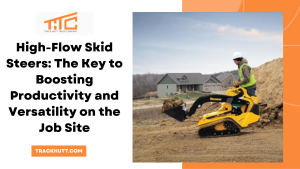
Skid steer loaders are incredibly versatile machines that can handle a wide range of tasks on the job site thanks to their ability to switch out attachments. These attachments are powered by the skid steer’s hydraulic system, which provides the power needed to perform various tasks.
However, not all attachments can be powered by a standard skid steer hydraulic system. Some attachments require a high-flow hydraulic system to function correctly. Plus, you’ll need to invest in the best rubber tracks for skid steer to ensure your high-flow systems are functioning efficiently.
In this blog, we will explore which skid steer attachments require high flow, what a high-flow skid steer is, the most popular high-flow attachments for skid steers, and the cost of a high-flow hydraulic system.
What is a high-flow skid steer?
A high-flow skid steer is a type of skid steer loader that is equipped with a high-flow hydraulic system. A standard skid steer hydraulic system typically operates at a flow rate of around 15-25 gallons per minute (GPM).
In contrast, a high-flow hydraulic system can provide flow rates of 30-45 GPM or higher. This increased flow rate allows certain attachments to operate more efficiently and effectively, as they require more hydraulic power to perform their tasks.
High-flow skid steers are typically used for heavy-duty applications that require a significant amount of hydraulic power, such as drilling through tough soil conditions, grinding up and mulching trees and brush, and breaking up concrete and other hard surfaces.
You can find prominent high-flow skid steers in a reputed online store. Sign up for regular newsletters to get updates on Bobcat, John Deere, or Vermeer skid steer for sale.
Which skid steer attachments require high flow?
Now that we know what a high-flow skid steer is, let’s take a look at some of the attachments that require high flow to function correctly.
- Auger – A high-flow hydraulic system is required to operate an auger attachment. This attachment requires a significant amount of hydraulic power to drill through tough soil conditions.
- Mulcher – Mulching attachments are used to grind up and mulch trees, brush, and other vegetation. These attachments require high flow to operate at their full potential, as they need a lot of hydraulic power to spin the cutting drum.
- Stump Grinder – Stump grinders are used to remove tree stumps from the ground. These attachments require high flow to operate efficiently, as they require a lot of hydraulic power to grind through tough tree stumps.
- Cold Planer – Cold planers are used to remove asphalt and concrete surfaces. These attachments require high flow to operate effectively, as they need a lot of hydraulic power to rotate the cutting drum.
- Hydraulic Hammer – Hydraulic hammers are used to break up concrete and other hard surfaces. These attachments require high flow to operate effectively, as they need a lot of hydraulic power to strike the surface.
Aside from the attachments mentioned above, there are several other popular high-flow attachments for skid steers. These include:
- High-Flow Trencher – A trencher is used to dig trenches for laying pipes, cables, and other underground utilities.
- High-Flow Sweeper – A sweeper attachment is used to clean up job sites and roadways.
- High-Flow Snow Blower – A snow blower attachment is used to clear snow from sidewalks, driveways, and other areas.
- High-Flow Brush Cutter – A brush cutter attachment is used to clear thick brush and vegetation from job sites and property.
What are the costs associated with a high-flow hydraulic system?
The cost of a high-flow hydraulic system for a skid steer can vary depending on a variety of factors, including the manufacturer, model, and size of the machine, as well as the specific needs of the job site and the attachments being used.
In general, a high-flow hydraulic system can cost anywhere from several thousand dollars to approximately tens of thousands of dollars. The cost of the system will typically include the necessary components, such as the high-flow pump, hoses, fittings, and valves, as well as any additional modifications, such as installing the best rubber tracks for skid steer and more.
While the cost of a high-flow hydraulic system can be significant, it is important to consider the benefits that it can provide. High-flow systems can increase the efficiency and versatility of a skid steer, allowing it to handle a wider range of attachments and tasks. This can result in a faster and more productive job site, which can ultimately save time and money in the long run.
It is vital to note that not all skid steers are capable of supporting a high-flow hydraulic system. Before investing in a high-flow system, it is important to consult with the manufacturer or a qualified dealer to ensure that the skid steer is compatible and can handle the increased hydraulic flow.
For affordable deals, browse reputed websites. You can find several brands, such as Toro or Vermeer skid steer, for sale.
Wrapping up
High-flow skid steers and the attachments they power are essential for heavy-duty applications that require high levels of hydraulic power. While the cost of a high-flow hydraulic system can be high, the efficiency and versatility it provides can make it a worthwhile investment.
Whether you’re in construction, forestry, landscaping, or any other industry that requires heavy-duty equipment, a high-flow skid steer can help you complete the job faster and more efficiently. By understanding the benefits and costs of a high-flow hydraulic system, you can make an informed decision and take your job site to the next level.